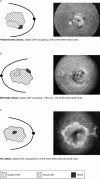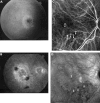Treatment of subfoveal choroidal neovascularisation in age related macular degeneration: focus on clinical application of verteporfin photodynamic therapy
- PMID: 11264143
- PMCID: PMC1723921
- DOI: 10.1136/bjo.85.4.483
Treatment of subfoveal choroidal neovascularisation in age related macular degeneration: focus on clinical application of verteporfin photodynamic therapy
Figures








Similar articles
-
Verteporfin : a review of its use in the management of subfoveal choroidal neovascularisation.Drugs. 2003;63(22):2521-54. doi: 10.2165/00003495-200363220-00016. Drugs. 2003. PMID: 14609361 Review.
-
Verteporfin therapy of subfoveal choroidal neovascularization in age-related macular degeneration: two-year results of a randomized clinical trial including lesions with occult with no classic choroidal neovascularization-verteporfin in photodynamic therapy report 2.Am J Ophthalmol. 2002 Jan;133(1):168-9. doi: 10.1016/s0002-9394(01)01237-5. Am J Ophthalmol. 2002. PMID: 11755871 Clinical Trial. No abstract available.
-
Retinal translocation and photodynamic therapy for age-related macular degeneration with classic choroidal neovascularization: a clinicopathologic case report.Retina. 2002 Dec;22(6):818-24. doi: 10.1097/00006982-200212000-00027. Retina. 2002. PMID: 12476118 No abstract available.
-
Photodynamic therapy of subfoveal choroidal neovascularization in age-related macular degeneration with verteporfin: one-year results of 2 randomized clinical trials--TAP report. Treatment of age-related macular degeneration with photodynamic therapy (TAP) Study Group.Arch Ophthalmol. 1999 Oct;117(10):1329-45. Arch Ophthalmol. 1999. PMID: 10532441 Clinical Trial.
-
Verteporfin ocular photodynamic therapy.Expert Opin Pharmacother. 2004 Jan;5(1):195-203. doi: 10.1517/14656566.5.1.195. Expert Opin Pharmacother. 2004. PMID: 14680447 Review.
Cited by
-
Verteporfin Photodynamic Therapy for the Treatment of Chorioretinal Conditions: A Narrative Review.Clin Ophthalmol. 2024 Jun 10;18:1701-1716. doi: 10.2147/OPTH.S464371. eCollection 2024. Clin Ophthalmol. 2024. PMID: 38881707 Free PMC article. Review.
-
Application and investigation of thrombopoiesis-stimulating agents in the treatment of thrombocytopenia.Ther Adv Hematol. 2023 Feb 27;14:20406207231152746. doi: 10.1177/20406207231152746. eCollection 2023. Ther Adv Hematol. 2023. PMID: 36865986 Free PMC article. Review.
-
Age-related macular degeneration.Ulster Med J. 2005 Sep;74(2):82-92. Ulster Med J. 2005. PMID: 16235759 Free PMC article. Review. No abstract available.
-
Verteporfin : a review of its use in the management of subfoveal choroidal neovascularisation.Drugs. 2003;63(22):2521-54. doi: 10.2165/00003495-200363220-00016. Drugs. 2003. PMID: 14609361 Review.
-
Giant neurosensory detachments associated with disciform lesions in neovascular age related macular degeneration.Br J Ophthalmol. 2003 Jun;87(6):795-6. doi: 10.1136/bjo.87.6.795-a. Br J Ophthalmol. 2003. PMID: 12770991 Free PMC article. No abstract available.
References
Publication types
MeSH terms
Substances
LinkOut - more resources
Full Text Sources
Other Literature Sources
Medical
